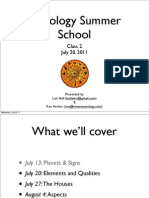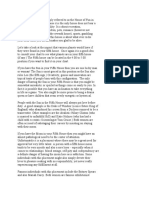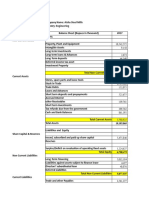Astrological Houses
Astrological Houses
Uploaded by
María GoldsteinCopyright:
Available Formats
Astrological Houses
Astrological Houses
Uploaded by
María GoldsteinOriginal Description:
Copyright
Available Formats
Share this document
Did you find this document useful?
Is this content inappropriate?
Copyright:
Available Formats
Astrological Houses
Astrological Houses
Uploaded by
María GoldsteinCopyright:
Available Formats
The 12 Astrological Houses: their Meaning
Astrological houses describe a specific field of experience in the native's real life. They indicate how the person functions, whether in his interactions with other people, his work, or his love affairs, etc. As with the 12 zodiacal signs, there are 12 astrological houses, and each house is in analogy with one of the signs. However, contrarily to signs, which spread invariably over 30 degrees of the zodiacal circle, house sizes may greatly vary from one house to the other. House calculations are based on the exact birth time. The cutting of the chart into 12 houses, referred to as "House system", varies from one astrologer to another. There are several methods: Placidus - the most ancient one, dating back to the 17th century - equal houses (with variants), Koch, Regiomontanus, Campanus, Alcabitius, Topocentric, Morinus, etc. It is important to note that most astrologers consider that whenever a planet is near a house cusp, it belongs to the said house. The threshold from a given house to the next depends on the authors' approach. It may vary from 1 to 6, sometimes 8 or 10. Some astrologers, quite the minority, prefer not to follow this rule. On Astrotheme, by default, we have chosen the Placidus system, and we take a classical stand, as far as the threshold is concerned. Thus, a planet found at less than 3 of the following house is considered to be in that house. We apply 2 in the case of the AS and the MC. On certain applications or on the Astrological Portrait, we offer the possibility to change these options and to select the equal houses or the Koch system. You may also decide to cancel the shift into the following house. Please note that such shift never involves the sign: a planet posited at 2929'29" Taurus is in this sign, and by no means in Gemini. When it comes to signs, total change is the rule, contrary to houses. As we wrote earlier, houses represent a specific area of life. We provide their meaning here:
The 1st house, referred to as the Ascendant: the Self, demeanour, and vitality.
It describes the personality, the natural demeanour of the native as he faces the outside world, and also his physical appearance. It is an essential component for the interpretation of the natal chart, and it is one of the four angles of the natal chart (the four most important houses, which are dealt with below). It is located on the left hand side of the natal chart and corresponds to the place where the sun rises.
The 2nd house: money earned and material goods.
It describes material goods, how they are managed, and how money is earned. In brief, it includes all financial matters but also represents greed and all sorts of possessions.
The 3rd house: immediate surroundings, siblings, short trips, and studies.
It deals with communication, the close environment (siblings, colleagues, schoolmates), primary and secondary education, apprenticeship. It also describes short trips, transportation, modern means of communication and all practical things.
The 4th house, referred to as the Imum Coeli: family, home, origins, heredity, and the father.
It represents the native's family, ancestors, roots, and home, both the home he comes from and the one he will set up. This house also describes the real estate patrimony, childhood, and emotions. It is located at the bottom of the chart, and like the Ascendant, it is an angular house.
The 5th house: love matters, pleasure, leisure, children, and creations.
It describes the person's creative and recreational activities, his hobbies, as well as his love affairs, his luck in gambling, his relationships with children in general, including his own. This house covers all pleasant things in the native's life.
The 6th house: everyday life, daily work and colleagues, lower-ranking coworkers, and health.
It describes the native's everyday life, his behaviour at work, minor obligations, servitudes, lower-ranking co-workers, and pets. It also concerns health, medicines and minor illnesses.
The 7th house, referred to as the Descendant: unions, marriage, other people, associations, and contracts.
It is opposite the 1st house and thus, represents other people, the native's behaviour towards other people, his partner (spouse or associate). It concerns contracts, associations, marriage and open enemies. It is through the 7th house that the native perceives other people. It is opposite the ASC, and is located on the right hand side of the natal chart and corresponds to the place where the sun sets.
The 8th house: passions and crises, transformations, death, financial investments, and sexuality.
It concerns the native's birth and death. However, it does not necessarily mean actual physical death. It may be a symbolic death, and thus, it is synonymous with evolution and transformation. This house also represents inheritances, money earned by other people, but also sexuality, power, all things hidden, and interest in occultism.
The 9th house: travels, abstract and higher concepts, spirituality, and foreign matters.
It is the realm of spirituality and philosophy, higher ideals, faraway travels, both physical and inner ones. Contrarily to the 3rd house, this house represents higher education and universities, as well as the understanding of abstract topics. It is also related to law and legality, and religion.
The 10th house, referred to as the Midheaven: social success, professional destiny, and the mother.
It is opposite the 4th house and corresponds to the native's professional career, as well as his social elevation as compared to his family background. It symbolises his ambitions and his achievements in the society. It is also related to the general public, potential fame, and the mother's influence. The 10th house is in the Southern part of the natal chart and located at its top.
The 11th house: friends, collective projects, supports and protections in life.
It represents the native's projects, his friends, and his protectors. It describes the nature of his friends, his group activities, and the place he occupies within the group,
contrarily to the more individualistic 5th house. This 11th house is related to all kinds of humanitarian topics.
The 12th house: enemies, difficulties, solitude, hidden ordeals, and secrets.
It corresponds to the native's inner self, ordeals underwent his whole life through, hidden enemies, and serious illnesses. It is related to places of confinement such as hospitals, prisons, convents, etc., and also includes solitude and major inner crises. The Tradition classifies houses because, on the one hand, their influence on an individual is not equally important, and on the other hand, they have different specificities in terms of characterology. There are three classifications. The first one deals with accentuation, and the other two, with quadrants and hemisphere emphasis. Here is a short outline of the three classifications:
The Accentuations
Houses are referred to as being angular, succedent or cadent. Angular houses are located at the four angles of the natal chart: the 1st house (the Ascendant or ASC), the 10th house (the Midheaven or MC), the 4th house (the Imum Coeli or IC), and the 7th house (the Descendant or DES). They are the most important houses of the natal chart, especially regarding the Ascendant and the Midheaven. If natal planets are posited near the angles (at less than 8 or 10 degrees, for instance), they become very prominent, and in many cases, they are part of the dominant planets. Succedent houses are located immediately after the angular houses: they are the 2nd, 5th, 8th, and 11th houses. They are less important than the angular houses and bring about less dynamism. However, they are a factor of stability. Cadent houses are the four following houses, i.e. the 3rd, 6th, 9th, and 12th houses. Although they are even less important than the succedent houses, they endow people having many planets in cadent houses with mobility and vivacity. Thus, we can say that there is an analogy between the principles of quadruplicities (Cardinal, Fixed, and Mutable mode), and sign and house accentuations.
The Quadrants
The Zodiac is divided into four quadrants of the same size. The first quadrant comprises the 1st, 2nd, and 3rd houses. They symbolise levels of consciousness of egotistical nature: persons with many planets in these sectors tend to pay utmost attention to their own interests and do not spontaneously care for others, but they are particularly dynamic or charismatic. The second quadrant comprises the 4th, 5th, and 6th houses. Sociability, creativity and daily work are highlighted. These qualities may be detrimental to the native's independence.
The third quadrant comprises the 7th, 8th, and 9th houses, which are of sheer interpersonal nature. Persons with many planets in these sectors are thirsting for company, and they need to charm and to progress through other people. The fourth quadrant comprises the 10th, 11th, and 12th houses, the sector of spiritual and humanitarian actions. Persons with many planets in these sectors are likely to be detached from individualistic considerations and are not interested in the practical side of things.
The Hemispheres
The Northern hemisphere comprises the 1st, 2nd, 3rd, 4th, 5th, and 6th houses. It is the lower half of the natal chart and indicates a personal, egotistical, subjective, and internalised typology. The Southern hemisphere comprises the 7th, 8th, 9th, 10th, 11th, and 12th houses. It is the upper half of the natal chart and indicates an active, objective, externalised, and group-oriented typology. The Eastern hemisphere comprises the 10th, 11th, 12th, 1st, 2nd, and 3rd houses. It is the left half of the natal chart, near the Ascendant. It indicates a typology marked by independence and personal action. The Western hemisphere comprises the 4th, 5th, 6th, 7th, 8th, and 9th houses. It is the right half of the natal chart, near the Descendant. It indicates the importance of communication, dependency on other people, as well as actions taken in relation with, and according to others.
You might also like
- WWW Pdfdrive Com Healing-Pluto-Problems-D175408017 HTML#TopDocument3 pagesWWW Pdfdrive Com Healing-Pluto-Problems-D175408017 HTML#TopDiego VegaNo ratings yet
- Seven Heavens-Wikip PDFDocument4 pagesSeven Heavens-Wikip PDFMaría GoldsteinNo ratings yet
- Physical AppearancesDocument27 pagesPhysical AppearancesTarik David BlountNo ratings yet
- How To Delineate A Horoscope by Sir CC ZainDocument12 pagesHow To Delineate A Horoscope by Sir CC Zains1234t67% (3)
- Pre-Natal Epoch McDonaldDraconicDocument1 pagePre-Natal Epoch McDonaldDraconicajakuk100% (1)
- The Space Between The Stars - The Nature and Function of The Planetary NodesDocument30 pagesThe Space Between The Stars - The Nature and Function of The Planetary Nodesaries25th3No ratings yet
- Peter Cetera-You're The InspirationDocument2 pagesPeter Cetera-You're The InspirationMaría GoldsteinNo ratings yet
- Water Distribution System Hydraulic ModelingDocument8 pagesWater Distribution System Hydraulic ModelingMichaelNo ratings yet
- The Meaning of The HousesDocument15 pagesThe Meaning of The HousesAnnie ToriNo ratings yet
- Houses and EffectsDocument3 pagesHouses and EffectscatchdgreenNo ratings yet
- 12 HousesDocument3 pages12 HousesBob SkinsNo ratings yet
- House in AstrologyDocument4 pagesHouse in AstrologyMoraru MarianaNo ratings yet
- ASTROLOGY: Decoding the Language of the Cosmos (2024 Guide for Novices)From EverandASTROLOGY: Decoding the Language of the Cosmos (2024 Guide for Novices)No ratings yet
- Part of Fortune in 7th House NatalDocument4 pagesPart of Fortune in 7th House NataltratakNo ratings yet
- Carter Principles2Document6 pagesCarter Principles2ddum292No ratings yet
- The PlanetsDocument16 pagesThe Planetsgabriela2203100% (2)
- The Houses Impacted by SaturnDocument18 pagesThe Houses Impacted by SaturnbalaNo ratings yet
- Ascendant Signs and Descriptions - IncarntologyDocument18 pagesAscendant Signs and Descriptions - Incarntologyborn_2_do_great_things100% (1)
- Retrograde PlanetsDocument5 pagesRetrograde PlanetsShivarubhanNo ratings yet
- (EBOOK) - Astrology - The 12 Houses PDFDocument4 pages(EBOOK) - Astrology - The 12 Houses PDFNish Pandya100% (1)
- The Dominant Planets of Kim JongDocument12 pagesThe Dominant Planets of Kim JongCelia SteimanNo ratings yet
- The Second House: Cyclical MeaningDocument3 pagesThe Second House: Cyclical MeaningHamida Eugenia GabrielliNo ratings yet
- Horoscope For Avneesh KumarDocument30 pagesHoroscope For Avneesh KumarAnonymous AQPr7tkSBNo ratings yet
- Astrology Summer School Class2Document34 pagesAstrology Summer School Class2Mia Bukovsky100% (3)
- Astrology Introduction To HousesDocument4 pagesAstrology Introduction To HousesTatiana CardosoNo ratings yet
- Ascendant Importance Paramount Considerations in Chart InterpretationDocument10 pagesAscendant Importance Paramount Considerations in Chart InterpretationpiyushNo ratings yet
- The 8 GatesDocument12 pagesThe 8 GatesAloysius ItokaNo ratings yet
- Placement of House RulersDocument3 pagesPlacement of House Rulerssonia0lavigneNo ratings yet
- Ascendants and Functional Malefics - Psychologically AstrologyDocument8 pagesAscendants and Functional Malefics - Psychologically AstrologyNick KolevNo ratings yet
- Planets in 5th HouseDocument4 pagesPlanets in 5th Housecatalina_206113870% (1)
- Mercury Conjunct Venus Synastry Natal Transit Meaning in AstrologyDocument5 pagesMercury Conjunct Venus Synastry Natal Transit Meaning in AstrologytratakNo ratings yet
- The Pisces Sagittarius SquareDocument12 pagesThe Pisces Sagittarius SquarejakilaNo ratings yet
- Planetary AspectsDocument10 pagesPlanetary AspectsphaniNo ratings yet
- Pluto As SingletonDocument12 pagesPluto As SingletonValentin BadeaNo ratings yet
- She's "Benefic" - Gentle: Basic NatureDocument6 pagesShe's "Benefic" - Gentle: Basic NatureMadan Mohan RawatNo ratings yet
- The Real Scoop On Mutual ReceptionDocument6 pagesThe Real Scoop On Mutual ReceptionReiki Master100% (2)
- Planets in SignsDocument13 pagesPlanets in SignsMihai Mirel RusuNo ratings yet
- Twelfth Parts and The Astrology of ProfessionDocument9 pagesTwelfth Parts and The Astrology of ProfessionMihaela DicuNo ratings yet
- Mercury in Leo and Aquarius - MakaraDocument6 pagesMercury in Leo and Aquarius - MakaraAndres AgassiNo ratings yet
- CUNNINGHAM - Why Saturn Has As Much To Do With Success As JupiterDocument15 pagesCUNNINGHAM - Why Saturn Has As Much To Do With Success As Jupitermanuverly2No ratings yet
- Natal Planets in Aspects With PlutoDocument3 pagesNatal Planets in Aspects With PlutoDanica Janković100% (1)
- AQUARIUSDocument8 pagesAQUARIUSRoxana TurotiNo ratings yet
- Solar Fire Dynamic Interpretations Report: (C) 2005, Esoteric Technologies Pty LTDDocument6 pagesSolar Fire Dynamic Interpretations Report: (C) 2005, Esoteric Technologies Pty LTDgannwong100% (1)
- The Twelfth House in AstrologyDocument6 pagesThe Twelfth House in Astrologytratak100% (3)
- Astrological Houses and Their Deeper MeaningsDocument4 pagesAstrological Houses and Their Deeper MeaningsAlejandra Guerrero100% (1)
- What Are Sun SignsDocument10 pagesWhat Are Sun Signsvuhoaithanh123No ratings yet
- Planets NatureDocument7 pagesPlanets NatureOmSilence2651No ratings yet
- Aspects and Aspecting Patterns in AstrologyDocument16 pagesAspects and Aspecting Patterns in AstrologyKurra Janaki Ram Kiran88% (8)
- Uranus in Astrology The Ultimate Guide To The Planet of Change (Planets in Astrology) (Mari Silva) (Z-Library)Document100 pagesUranus in Astrology The Ultimate Guide To The Planet of Change (Planets in Astrology) (Mari Silva) (Z-Library)koushikNo ratings yet
- The STELLIUM 4 or More Planets in The Same House Lynn Koiner Astrological ResearchDocument3 pagesThe STELLIUM 4 or More Planets in The Same House Lynn Koiner Astrological ResearchSundar RamanathanNo ratings yet
- Dane Rudhyar - Progressions in AstrologyDocument14 pagesDane Rudhyar - Progressions in AstrologyRoy VergesNo ratings yet
- As Teroid S: BymaryestherandrewsDocument7 pagesAs Teroid S: BymaryestherandrewsturtlespiritflutesNo ratings yet
- JupiterDocument2 pagesJupiterOtilia MaziluNo ratings yet
- Behind The Mask. The Rising Sign Libra and Piscis. AstrologyDocument39 pagesBehind The Mask. The Rising Sign Libra and Piscis. AstrologyBox100% (1)
- How To Judge A HoroscopeDocument3 pagesHow To Judge A HoroscopeVibhutiGanesh JiNo ratings yet
- The Facets of FateDocument23 pagesThe Facets of FatetelemacusNo ratings yet
- InterceptionDocument6 pagesInterceptionThe ManNo ratings yet
- Astrology - A FortuneDocument7 pagesAstrology - A Fortunemeochauphi100% (1)
- Saturn Determines The Course of DestinyDocument7 pagesSaturn Determines The Course of DestinyKrishna CHNo ratings yet
- Planets PDFDocument6 pagesPlanets PDFShivarubhan100% (1)
- Career: Definitions and Etymology Historic Changes in Careers Career ManagementDocument6 pagesCareer: Definitions and Etymology Historic Changes in Careers Career ManagementMaría GoldsteinNo ratings yet
- Articulated Bus-WikipDocument9 pagesArticulated Bus-WikipMaría GoldsteinNo ratings yet
- Ayyavazhi Mythology - WikipDocument10 pagesAyyavazhi Mythology - WikipMaría GoldsteinNo ratings yet
- Tom Jones-I Who Have NothingDocument2 pagesTom Jones-I Who Have NothingMaría GoldsteinNo ratings yet
- Celestial SpheresDocument10 pagesCelestial SpheresMaría Goldstein100% (1)
- ASMR-Autonomous Sensory Meridian ResponseDocument5 pagesASMR-Autonomous Sensory Meridian ResponseMaría GoldsteinNo ratings yet
- Argentina Map Argentina Map Argentina Map Argentina Map: Maps of WorldDocument4 pagesArgentina Map Argentina Map Argentina Map Argentina Map: Maps of WorldMaría GoldsteinNo ratings yet
- Almagest Ptolemy Wikip PDFDocument6 pagesAlmagest Ptolemy Wikip PDFMaría GoldsteinNo ratings yet
- Astrology-Planet MercuryDocument2 pagesAstrology-Planet MercuryMaría GoldsteinNo ratings yet
- English-Simple Present FormsDocument1 pageEnglish-Simple Present FormsMaría GoldsteinNo ratings yet
- The Carpenters - SingDocument1 pageThe Carpenters - SingMaría Goldstein100% (1)
- The Carpenters-Yesterday Once MoreDocument2 pagesThe Carpenters-Yesterday Once MoreMaría Goldstein100% (1)
- Michael Jackson - UnbreakableDocument2 pagesMichael Jackson - UnbreakableMaría GoldsteinNo ratings yet
- The Carpenters-We'Ve Only Just BegunDocument1 pageThe Carpenters-We'Ve Only Just BegunMaría GoldsteinNo ratings yet
- Josh Groban-What Child Is ThisDocument1 pageJosh Groban-What Child Is ThisMaría GoldsteinNo ratings yet
- Josh Groban-To Where You AreDocument1 pageJosh Groban-To Where You AreMaría GoldsteinNo ratings yet
- Josh Groban-You Are Still YouDocument1 pageJosh Groban-You Are Still YouMaría GoldsteinNo ratings yet
- Josh Groban-Silent NightDocument1 pageJosh Groban-Silent NightMaría GoldsteinNo ratings yet
- The Carpenters-This MasqueradeDocument1 pageThe Carpenters-This MasqueradeMaría GoldsteinNo ratings yet
- Michael Jackson - Earth SongDocument3 pagesMichael Jackson - Earth SongMaría GoldsteinNo ratings yet
- Josh Groban-When You Say You Love MeDocument1 pageJosh Groban-When You Say You Love MeMaría GoldsteinNo ratings yet
- Josh Groban - RememberDocument1 pageJosh Groban - RememberMaría GoldsteinNo ratings yet
- Josh Groban-Let Me Fall (From Cirque Du Soleil)Document1 pageJosh Groban-Let Me Fall (From Cirque Du Soleil)María GoldsteinNo ratings yet
- Glossary of Professional Wrestling TermsDocument14 pagesGlossary of Professional Wrestling TermsMaría GoldsteinNo ratings yet
- Standard Crystals GlossaryDocument2 pagesStandard Crystals GlossaryMaría GoldsteinNo ratings yet
- Tennis-Glossary of Tennis TermsDocument15 pagesTennis-Glossary of Tennis TermsMaría Goldstein100% (1)
- Entomology - Glossary of Entomology TermsDocument16 pagesEntomology - Glossary of Entomology TermsMaría Goldstein100% (2)
- Peter Cetera-Glory of LoveDocument2 pagesPeter Cetera-Glory of LoveMaría GoldsteinNo ratings yet
- Wel-Come To Ravenshaw University, Cuttack AMIT PDFDocument1 pageWel-Come To Ravenshaw University, Cuttack AMIT PDFSambit Kumar BiswalNo ratings yet
- Homelux 2023Document9 pagesHomelux 2023Moreblessing MakomekeNo ratings yet
- 4A1 - Ôn Tập Cuối Học Kỳ I - Phần 2Document7 pages4A1 - Ôn Tập Cuối Học Kỳ I - Phần 2Thảo PhươngNo ratings yet
- Aisha Steel Annual Report 2015Document33 pagesAisha Steel Annual Report 2015qamber18No ratings yet
- ASIATMPDocument5 pagesASIATMPNusrat JahanNo ratings yet
- Spring ProtectionDocument6 pagesSpring ProtectionOxfamNo ratings yet
- Annex II - Cadastral Registration ProceedingsDocument1 pageAnnex II - Cadastral Registration ProceedingsMiGay Tan-PelaezNo ratings yet
- Miranda KerrDocument25 pagesMiranda KerrKemberly Semaña PentonNo ratings yet
- Aditya's NotesDocument8 pagesAditya's NotesNavya BhandariNo ratings yet
- MAG Technology & Trading qt-00267Document2 pagesMAG Technology & Trading qt-00267Lynn AhmadNo ratings yet
- Case Study On Bohra CuisineDocument72 pagesCase Study On Bohra CuisineSaransh Saini100% (3)
- Important Acts in India - All Important Acts and Reforms Till 2023 - PWOnlyIASDocument26 pagesImportant Acts in India - All Important Acts and Reforms Till 2023 - PWOnlyIASkumaralokyadav14No ratings yet
- JR Engineer ElectricalPMLDocument3 pagesJR Engineer ElectricalPMLarti suryawanshiNo ratings yet
- Badminton RulesDocument9 pagesBadminton RulesJelly ArguellesNo ratings yet
- Rice Factories ActDocument15 pagesRice Factories ActMarkAminNo ratings yet
- Will Kymlicka's Views On Multicultural Citizenship: (I) Self-Government RightsDocument2 pagesWill Kymlicka's Views On Multicultural Citizenship: (I) Self-Government Rightssurbhi sharmaNo ratings yet
- BOW - Komunikasyon at PananaliksikDocument4 pagesBOW - Komunikasyon at PananaliksikDeraj LagnasonNo ratings yet
- Chap10 ExcelDocument2 pagesChap10 ExcelBonaventure NzeyimanaNo ratings yet
- Section 1 Rule 138 and BAR MatterDocument16 pagesSection 1 Rule 138 and BAR MattermzhleanNo ratings yet
- James Brannigan ResumeDocument2 pagesJames Brannigan ResumeSureshkumaryadavNo ratings yet
- Blogger For Beginners: Unlimited Organic Free Traffic For You!Document11 pagesBlogger For Beginners: Unlimited Organic Free Traffic For You!daily dealsNo ratings yet
- IJOPM MoralapproachtostakeholdermanagementDocument29 pagesIJOPM MoralapproachtostakeholdermanagementveronicamisiedjanNo ratings yet
- Recount Text 1 ExamDocument5 pagesRecount Text 1 ExamRomi Andriansyah AeNo ratings yet
- Huma TempleDocument3 pagesHuma TempleS.s. Michael0% (1)
- Prelim - The Teaching ProfessionDocument40 pagesPrelim - The Teaching ProfessionRuby ConcepcionNo ratings yet
- Woman Craft in HarariDocument13 pagesWoman Craft in HarariMohammed Jemal AhmedNo ratings yet
- Aflac Hospital Indemnity - BrochureDocument4 pagesAflac Hospital Indemnity - BrochuregalaganrxNo ratings yet
- Varanasi Guide Low Res PDFDocument38 pagesVaranasi Guide Low Res PDFinformation technology auditNo ratings yet
- Educ 9Document22 pagesEduc 9d o sNo ratings yet























































































































